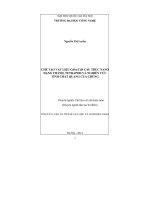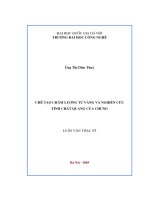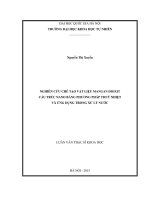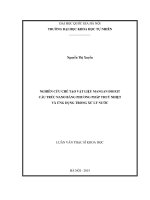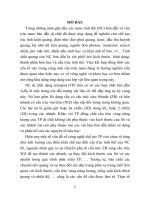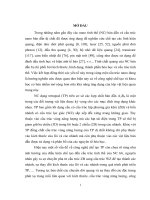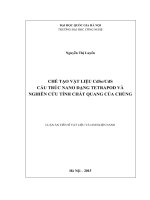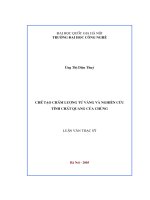Chế tạo vật liệu cdse cds cấu trúc nano dạng tetrapod và nghiên cứu tính chất quang của chúng
Bạn đang xem bản rút gọn của tài liệu. Xem và tải ngay bản đầy đủ của tài liệu tại đây (463.14 KB, 28 trang )
ĐẠI HỌC QUỐC GIA HÀ NỘI
TRƢỜNG ĐẠI HỌC CÔNG NGHỆ
Nguyễn Thị Luyến
CHẾ TẠO VẬT LIỆU CdSe/CdS
CẤU TRÚC NANO DẠNG TETRAPOD VÀ
NGHIÊN CỨU TÍNH CHẤT QUANG CỦA CHÚNG
LUẬN ÁN TIẾN SĨ VẬT LIỆU VÀ LINH KIỆN NANO
Hà Nội – 2015
ĐẠI HỌC QUỐC GIA HÀ NỘI
TRƢỜNG ĐẠI HỌC CÔNG NGHỆ
-----------------
Nguyễn Thị Luyến
CHẾ TẠO VẬT LIỆU CdSe/CdS
CẤU TRÚC NANO DẠNG TETRAPOD VÀ
NGHIÊN CỨU TÍNH CHẤT QUANG CỦA CHÚNG
LUẬN ÁN TIẾN SĨ VẬT LIỆU VÀ LINH KIỆN NANO
Chuyên ngành: Vật liệu và Linh kiện nano
(Chuyên ngành đào tạo thí điểm)
NGƢỜI HƢỚNG DẪN KHOA HỌC:
1. PGS.TS. Nguyễn Xuân Nghĩa
2. PGS.TS. Nguyễn Kiên Cƣờng
Hà Nội - 2015
LỜI CAM ĐOAN
Tôi xin cam đoan đây là công trình nghiên cứu của riêng tôi dưới sự
hướng dẫn của PGS.TS. Nguyễn Xuân Nghĩa và PGS.TS. Nguyễn Kiên
Cường. Các số liệu, kết quả trong luận án là trung thực và chưa từng được ai
công bố trong bất kì công trình nào khác.
Tác giả luận án
Nguyễn Thị Luyến
LỜI CẢM ƠN
Đầu tiên, em xin được gửi lời cảm ơn chân thành đến PGS.TS. Nguyễn
Xuân Nghĩa và PGS.TS. Nguyễn Kiên Cường đã tận tình hướng dẫn em trong
nghiên cứu khoa học và giúp đỡ em hoàn thành luận án.
Em xin chân thành cảm ơn các Thầy, Cô giáo trong Khoa Vật lý Kỹ
thuật và Công nghệ nano - Trường Đại học Công nghệ - ĐHQG HN đã tận
tình dạy dỗ và tạo mọi điều kiện thuận lợi nhất về cơ sở vật chất giúp em
hoàn thành luận án.
Xin bày tỏ lời cảm ơn chân thành đến Khoa Vật lý và Công nghệ,
Trường Đại học Khoa học - Đại học Thái nguyên đã tạo mọi điều kiện thuận
lợi để tôi được đi làm NCS và hoàn thành chương trình đào tạo.
Tôi xin gửi lời cảm ơn đến Phòng thí nghiệm trọng điểm, Viện Khoa
học vật liệu - Viện Hàn lâm KH&CN VN đã tạo mọi điều kiện thuận lợi về cơ
sở vật chất và các trang thiết bị giúp tôi hoàn thành được luận án.
Tôi xin cảm ơn tất cả các anh, chị, em là NCS, học viên cao học, sinh
viên học tập và làm việc tại Phòng thí nghiệm trọng điểm, Viện Khoa học vật
liệu - Viện Hàn lâm KH&CN VN đã cùng tôi chuẩn bị và thực hiện công nghệ
chế tạo và khảo sát các đặc trưng của vật liệu.
Tôi xin cảm ơn chân thành đến TS. Lê Bá Hải đã tận tình giúp tôi trong
nghiên cứu khoa học, TS. Trần Quang Huy đã giúp tôi thực hiện phép đo
khảo sát hình dạng, TS. Đỗ Ngọc Chung đã hướng dẫn tôi thực hiện phép đo
khảo sát hấp thụ quang của vật liệu.
Cuối cùng, tôi xin được gửi lời cảm ơn đến gia đình, bạn bè, đồng
nghiệp đã luôn bên cạnh động viên, khích lệ tôi trong những giai đoạn khó
khăn nhất.
Luận án được thực hiện với sự hỗ trợ kinh phí của Trường Đại học
Khoa học - Đại học Thái nguyên, Phòng thí nghiệm trọng điểm, Viện Khoa
học vật liệu - Viện Hàn lâm KH&CN VN.
MỤC LỤC
Trang
Danh mục các ký hiệu và chữ viết tắt ................................................................ i
Danh mục các bảng .......................................................................................... iii
Danh mục các hình vẽ và đồ thị ....................................................................... iv
Ký hiệu các mẫu nghiên cứu .......................................................................... xiv
MỞ ĐẦU ........................................................................................................... 1
Chƣơng 1. TỔNG QUAN VỀ CHẾ TẠO VÀ TÍNH CHẤT QUANG
CỦA TETRAPOD ............................................................................................ 5
1.1. Chế tạo……................................................................................................ 5
1.1.1. Các cơ chế tạo thành tetrapod ............................................................ 5
1.1.2. Ảnh hƣởng của nhiệt độ phản ứng và ligand đến cấu trúc tinh thể....7
1.1.3. Kỹ thuật chế tạo tetrapod đồng chất và dị chất ................................ 11
1.2. Tính chất quang ........................................................................................ 17
1.2.1. Cấu trúc vùng năng lƣợng và phân bố hạt tải..................................17
1.2.2. Các giải pháp điều khiển phân bố hạt tải……. ............................... 19
1.2.3. Cấu trúc điện tử và tính chất quang ................................................ 21
1.2.4. Ảnh hƣởng của công suất kích thích quang .................................... 25
1.2.5. Ảnh hƣởng của nhiệt độ .................................................................. 29
Kết luận chƣơng 1 ........................................................................................... 33
Chƣơng 2. THỰC NGHIỆM ........................................................................... 34
2.1. Chế tạo...................................................................................................... 34
2.1.1. Nguyên liệu và hóa chất ................................................................... 34
2.1.2. Chế tạo các dung dịch tiền chất ....................................................... 35
2.1.3. Tetrapod CdSe.................................................................................. 35
2.1.4. Tetrapod dị chất ............................................................................... 36
2.1.5. Tetrapod-giếng lƣợng tử .................................................................. 40
2.1.6. Làm sạch mẫu ................................................................................... 42
2.2. Các phƣơng pháp khảo sát đặc trƣng của mẫu ......................................... 42
2.2.1. Hiển vi điện tử truyền qua ................................................................ 43
2.2.2. Nhiễu xạ tia X .................................................................................. 43
2.2.3. Hấp thụ quang .................................................................................. 44
2.2.4. Quang huỳnh quang ......................................................................... 44
2.2.5. Kích thích quang huỳnh quang ........................................................ 46
Kết luận chƣơng 2 ........................................................................................... 47
Chƣơng 3. KẾT QUẢ NGHIÊN CỨU CHẾ TẠO TETRAPOD CdSe,
CdSe/CdS VÀ TETRAPOD-GIẾNG LƢỢNG TỬ LÕI (ZB-CdSe)/
NHÁNH (WZ-CdSe/CdSe1-xSx/CdSe1-ySy/CdSe1-zSz) .................................... 48
3.1. Tetrapod CdSe .......................................................................................... 48
3.2. Tetrapod dị chất........................................................................................ 52
3.2.1. Vai trò của axit oleic và tri-n-octylphosphine đối với
cấu trúc tinh thể của NC CdSe ...................................................... ..52
3.2.2. Ảnh hƣởng của nồng độ tiền chất và oleylamine đến
sự phát triển các nhánh CdS từ lõi CdSe ........................................ 57
3.3. Tetrapod-giếng lƣợng tử .......................................................................... 67
Kết luận chƣơng 3 ........................................................................................... 73
Chƣơng 4. KẾT QUẢ NGHIÊN CỨU TÍNH CHẤT QUANG CỦA
TETRAPOD CdSe, CdSe/CdSe1-xSx VÀ TETRAPOD-GIẾNG LƢỢNG TỬ
LÕI (ZB-CdSe)/NHÁNH (WZ-CdSe/CdSe1-xSx/CdSe1-ySy/CdSe1-zSz).......... 74
4.1. Tetrapod CdSe .......................................................................................... 74
4.1.1. Đặc trƣng hấp thụ và quang huỳnh quang……...............................74
4.1.2. Bản chất các chuyển dời quang ....................................................... 79
4.1.3. Sự phụ thuộc công suất kích thích quang ....................................... 84
4.2. Tetrapod dị chất và tetrapod-giếng lƣợng tử............................................86
4.2.1. Các mẫu nghiên cứu ........................................................................ 86
4.2.2. Sự tái chuẩn hóa vùng cấm ............................................................. 90
4.2.3. Sự truyền hạt tải từ giếng thế vào lõi .............................................. 97
4.2.4. Hiện tƣợng chống dập tắt huỳnh quang do nhiệt độ
và dập tắt huỳnh quang tại nhiệt độ thấp ........................................ 99
Kết luận chƣơng 4 ......................................................................................... 109
KẾT LUẬN ................................................................................................... 110
DANH MỤC CÔNG TRÌNH KHOA HỌC CỦA TÁC GIẢ
LIÊN QUAN ĐẾN LUẬN ÁN ..................................................................... 112
TÀI LIỆU THAM KHẢO ............................................................................. 114
PHỤ LỤC ...................................................................................................... 132
DANH MỤC CÁC KÝ HIỆU VÀ CHỮ VIẾT TẮT
1. Các ký hiệu
e: Điện tử
Eg: Năng lƣợng vùng cấm
h: Lỗ trống
IPL: Cƣờng độ PL tích phân
: Hệ số nhiệt độ
kB: Hằng số Boltzmann
: Nhiệt độ Debye
n: Nồng độ hạt tải
: Hệ số chuẩn hóa vùng cấm
P: Công suất kích thích quang
: Hằng số Planck
r: Bán kính
γ : Hệ số góc của đƣờng làm khớp
T: Nhiệt độ
d: Đƣờng kính
m: số phonon LO
Ea: Năng lƣợng kích hoạt nhiệt
[…]: Nồng độ tiền chất …
2. Các chữ viết tắt
Chữ
viết tắt
Tiếng Anh
Tiếng Việt
BGR
Band gap renormalization
Tái chuẩn hóa vùng cấm
CB
Conduction band
Vùng dẫn
FWHM
Full width at half maximum
Độ rộng phổ tại nửa cực đại
HDA
Hexadecylamine
Hexadecylamine
High resolution transtion
Hiển vi điện tử truyền qua phân
electronic microscopy
giải cao
LO
Longitudinal optical
Quang dọc
ML
Monolayer
Đơn lớp
MPA
Methylphosphonic acid
Axit methylphosphonic
MQW
Multiquantum well
Nhiều giếng lƣợng tử
NC
Nanocrystal
Nano tinh thể
HRTEM
i
OA
Oleic acid
Axit oleic
OAm
Oleylamine
Oleylamine
ODE
Octadecene
Octadecene
ODA
Octadecylamine
Octadecylamine
ODPA
Octadecylphosphonic acid
Axit octadecylphosphonic
PL
Photoluminescence
Quang huỳnh quang
PLE
Photoluminescence excitation Kích thích quang huỳnh quang
Photoluminescence
Hiệu suất lƣợng tử
quantum yield
quang huỳnh quang
PPA
Propylphosphonic acid
Axit propylphosphonic
QD
Quantum dot
Chấm lƣợng tử
TBP
Tributylphosphine
Tributylphosphine
TDPA
Tetradecylphosphonic acid
Axit tetradecylphosphonic
PL QY
TEM
TMPPA
Transtion electronic
Hiển vi điện tử truyền qua
microscopy
Bis(2,2,4trimethylpentyl)phos Axit bis(2,2,4phinic acid
trimethylpentyl)phosphinic
TOP
Tri-n-octylphosphine
Tri-n-octylphosphine
TOPO
Trioctylphosphine oxide
Oxit trioctylphosphine
TP
Tetrapod
Tetrapod
TPQW
Tetrapod-Quantum well
Tetrapod-giếng lƣợng tử
UCL
Up-convertion luminescence
VB
Valence band
Vùng hóa trị
WZ
Wurtzite
Lục giác
XRD
X-ray diffraction
Nhiễu xạ tia X
ii
Huỳnh quang
chuyển đổi ngƣợc
ZB
Zinc blende
Lập phƣơng giả kẽm
0D
Zero-dimensional
Không chiều
1D
One- dimensional
Một chiều
2D
Two- dimensional
Hai chiều
DANH MỤC CÁC BẢNG
Trang
Bảng 2.1. Ký hiệu và điều kiện chế tạo các mẫu TP CdSe..........................36
Bảng 2.2. Các điều kiện chế tạo nhánh theo qui trình hai bƣớc
(các thí nghiệm 1 và 2) và chế tạo lõi, nhánh theo qui
trình liên tiếp (thí nghiệm 3) ......................................................... 40
Bảng 2.3. Điều kiện chế tạo hai loại mẫu TPQW........................... .............. 42
Bảng 3.1. Các điều kiện chế tạo NC CdSe và CdS ....................................... 55
Bảng 3.2. Điều kiện chế tạo các mẫu TPQW có tỉ số các cƣờng độ
phát xạ tích phân của QW và lõi CdSe khác nhau........................ 72
Bảng 4.1. Ký hiệu và điều kiện chế tạo các cặp mẫu lõi-TP dị chất
và lõi-TPQW đƣợc sử dụng để nghiên cứu tính chất quang ........ 87
Bảng 4.2. Giá trị của các thông số làm khớp theo biểu thức Varshni ........ 104
iii
TÀI LIỆU THAM KHẢO
Tiếng Việt
1.
Lê Bá Hải (2010), Chế tạo và nghiên cứu tính chất quang của một
số cấu trúc lượng tử trên cơ sở CdSe, Luận án Tiến sĩ Vật lý, Viện
Hàn lâm Khoa học và Công nghệ Việt Nam.
Tiếng Anh
2.
Al Salman A., Tortschanoff A., Mohamed M.B., Tonti D., van
Mourik F., Chergui M. (2007), "Temperature effects on the spectral
properties of colloidal CdSe nanodots, nanorods, and tetrapods", Appl.
Phys. Lett. 90, pp. 093104(1)-093104(3).
3.
Alén B., Fuster D., Muñoz-Matutano G., Martínez-Pastor J., González
Y., Canet-Ferrer J. and González L. (2008), "Exciton Gas
Compression and Metallic Condensation in a Single Semiconductor
Quantum Wire", Phys. Rev. Lett. 101, pp. 067405(1)- 067405(4).
4.
Alivisatos A.P., Gu W., Larabell C. (2005), "Quantum dots as cellular
probes", Annu. Rev. Biomed. Eng. 7, pp. 55-76.
5.
Allen P.B. and Cardona M. (1983), “Temperature dependence of the
direct gap of Si and Ge”, Phys. Rev. B 27, pp. 4760-4769.
6.
Al-Salim N., Young A.G., Tilley R.D., Mc Quillan A.J., Xia J.
(2007), “Synthesis CdSeS Nanocrystals in Coordinating and
Noncoordinating Solvents: Solvent‟s Role in Evolution of the Optical
and Structural Properties”, Chem. Mater. 19, pp. 5185-5193.
7.
Ambigapathy R., Bar-Josept I., Oberli D.Y., Haacke S., Brasil M.J.,
Reinhardt F., Kapon. E. and Deveaud B. (1997), "Coulomb
correlation and band gap renormalization at high carrier densities in
quantum wires", Phys. Rev. Lett. 78, pp, 3579-3582.
114
8.
Bae W.K., Kwak J., Lim J., Lee D., Nam M.K., Char K., Lee C., Lee
S. (2010), "Multicolored Light-Emitting Diodes Based on AllQuantum-Dot Multilayer Films Using Layer-by-Layer Assembly
Method", Nano Lett. 10, pp. 2368-2373.
9.
Bae W.K., Padilha L.A., Park Y.S., McDaniel H., Robel I., Pietryga
J.M., Klimov V.I. (2013), "Controlled Alloying of the Core−Shell
Interface in CdSe/CdS Quantum Dots for Suppression of Auger
Recombination", ACS Nano 7, pp. 3411-3419.
10.
Battaglia D., Blackman B. and Peng X. (2005), “Coupled and
Decoupled
Dual
Quantum
Systems
in
One
Semiconductor
Nanocrystal”, J. Am. Chem. Soc. 127, pp. 10889-10897.
11.
Blackman B., Battaglia D., Peng X. (2008), "Bright and Water
Soluble
Near
IR-Emitting
CdSe/CdTe/ZnSe
Type-II/Type-I
Nanocrystals, Tuning the Efficiency and Stability by Growth", Chem.
Mater. 20, pp. 4847-4853.
12.
Brokmann X., Messin G., Desbiolles P., Giacobino E., Dahan M.,
Hermier J.P. (2004), "Colloidal CdSe/ZnS quantum dots as singlephoton sources", New. J. Phys. 6, pp. 99(1)-99(8).
13.
Brovelli S., Bae W.K., Galland C., Giovanella U., Meinardi F. and
Klimov V.I. (2014), "Dual-Color Electroluminescence from Dot-inBulk Nanocrystals", Nano Lett. 14, pp. 486-494.
14.
Camacho J., Loa I., Cantarero A., Calderon I.H. (2002), “Temperature
dependence of Raman scattering and luminescence of the disordered
Zn0.5Cd0.5Se alloy”, Microel. J. 33, pp. 349-353.
15.
Cao Y.C., Wang J. (2004), “One-Pot Synthesis of High-Quality Zinc
Blende CdS Nanocrystals”, J. Am. Chem. Soc. 126, pp. 14336-14337.
16.
Carbone L., Kudera S., Carlino E., Wolfgang J.P., Giannini C.,
115
Cingolani R. and Manna L. (2005), “Multiple Wurtzite Twinning in
CdTe Nanocrystals Induced by Methylphosphonic Acid”, J. Am.
Chem. Soc. 128, pp. 748-755.
17.
Carbone L., Nobile C., De Giorgi M., Della S.F., Morello G., Pompa
P., Hytch M., Snoeck E., Fiore A., Franchini I., Nadasan M., Silvestre
A.F., Chiodo L., Kudera S., Cingolani R., Krahne R., Manna L.
(2007), "Synthesis and Micrometer-Scale Assembly of Colloidal
CdSe/CdS Nanorods Prepared by a Seeded Growth Approach", Nano
Lett. 7, pp. 2942-2950.
18.
Chen W., Joly A.G., McCready D.E. (2005), “Upconversion
luminescence from CdSe nanoparticals”, J. Chem. Phys. 122, pp.
224708(1)-224708(4).
19.
Chen X., Lou Y., Samia A.C. and Burda C. (2003), "Coherency Strain
Effects on the Optical Response of Core/Shell Heteronanostructures",
Nano Lett. 3, pp. 799-803.
20.
Chin P.T.K., De Mello Donega C., Van Bavel S.S., Meskers S.C.J.,
Sommerdijk N.A.J.M., Janssen R.A.J. (2007), "Highly luminescent
CdTe/CdSe colloidal heteronanocrystals with temperature-dependent
emission color", J. Am. Chem. Soc. 129, pp. 14880-14886.
21.
Chiu Y.S., Ya M.H., Su W.S. and Chen Y.F. (2002), "Properties of
photoluminescence in type-II GaAsSb/GaAs multiple quantum
wells", J. Appl. Phys. 92, pp. 5810-5813.
22.
Dai Q., Wang Y., Zang Y., Li X., Li R., Zou B., Seo J.T., Wang Y.,
Liu M., Yu W.W. (2009), "Stability Study of PbSe Semiconductor
Nanocrystals over Concentration, Size, Atmosphere, and Light
Exposure", Langm. 25, pp. 12320-12324.
23.
Dalgarno P.A., Ediger M., Gerardot B.D., Smith J.M., Seidl S.,
116
Kroner M., Karrai K., Petroff P.M., Govorov A.O. and Warburton
R.J. (2008), "Optically Induced Hybridization of a Quantum Dot State
with a Filled Continuum", Phys. Rev. Lett. 100, pp. 176801(1)176801(4).
24.
Dallari W., Abbusco M.S., Zanella M., Marras S., Manna L., Diaspro
A.
and
Allione
M.
(2012),
"Light-Induced
Inhibition
of
Photoluminescence Emission of Core/ Shell Semiconductor Nanorods
and Its Application for Optical Data Storage", J. Phys. Chem. C 116,
pp. 25576-25580.
25.
Dang C., Lee. J., Breen C., Steckel J.S., Coe-Sullivan S., Nurmikko
A. (2012), “Red, green and blue lasing enabled by single-exciton gain
in colloidal quantum dot films”, Nat. Nanotechnol. 7, pp. 335-339.
26.
De Mello Donega C. (2010), "Formation of nanoscale spatially
indirect excitons: Evolution of the type-II optical character of
CdTe/CdSe heteronanocrystals", Phys. Rev. B 81, pp. 165303(1)165303(20).
27.
Deka S., Quarta A., Lupo M.G., Falqui A., Boninelli S., Giannini C.,
Morello G., Giorgi D.M., Lanzani G., Spinella C., Cingolani R.,
Pellegrino T. and Manna L. (2009), “CdSe/CdS/ZnS Double Shell
Nanorods with High Photoluminescence Efficiency and Their
Exploitation As Biolabeling Probes”, J. Am. Chem. Soc. 131, pp.
2948-2958.
28.
Deng Z., Cao L., Tang F., Zou B. (2005), “A New Route to Zinc
Blende CdSe Nanocrystals: Mechanism and Synthesis”, J. Phys.
Chem. B 109, pp. 16671-16675.
29.
Deng Z., Tong L., Flores M., Lin S., Cheng J.X., Yan H. and Liu Y.
(2011), "High-Quality Manganese-Doped Zinc Sulfide Quantum
117
Rods with Tunable Dual-Color and Multiphoton Emissions", J. Am.
Chem. Soc. 133, pp. 5389-5396.
30.
Dubertret B., Skourides P., Norris D.J., Noireaux V., Brivanlou A.H.,
Libchaber A. (2002), "In Vivo Imaging of Quantum Dots
Encapsulated in Phospholipid Micelles", Sci. 298, pp. 1759-1762.
31.
Embden J.V., Mulvaney P. (2005), “Nucleation and Growth of CdSe
Nanocrystals in a Binary Ligand System”, Langm. 21, pp. 1022610233.
32.
Fiore A., Mastria R., Lupo M.G., Lanzani G., Giannini C., Carlino E.,
Morello G., Giorgi M.D., Li Y., Cingolani R. and Manna L. (2009),
“Tetrapod-Shaped Colloidal Nanocrystals of II VI Semiconductors
Prepared by Seeded Growth”, J. Am. Chem. Soc. 131, pp. 2274-2282.
33.
Galland C., Brovelli S., Bae W.K., Padilha L.A., Meinardi F., Klimov
V.I. (2013), "Dynamic Hole Blockade Yields Two-Color Quantum
and Classical Light from Dot-in-Bulk Nanocrystals”, Nano Lett. 13,
pp. 321-328.
34.
Gélinas G., Lanacer A., Leonelli R., Masut R.A. and Poole P.J.
(2010), "Carrier thermal escape in families of InAs/InP selfassembled quantum dots", Phys. Rev. B 81, pp. 235426(1)235426(7).
35.
Ghanassi M., Schanne-Klein M.C., Hache F., Ekimov A.I., Ricard
D. and Flytzanis C. 1993, “Time‐resolved measurements of carrier
recombination
in
experimental
semiconductor‐doped
glasses:
Confirmation of the role of Auger recombination”, Appl. Phys. Lett.
62, pp. 78-80.
36.
Han L., Qin D., Jiang X., Liu Y., Wang L., Chen J., Cao Y. (2006),
“Synthesis of High Quality Zinc Blende CdSe Nanocrystals and Their
118
Application in Hybrid Solar Cells”, Nanotechnol. 17, pp. 4736-4742.
37.
Heitz R., Guffarth F., Mukhametzhanov I., Grundmann M., Madhukar
A. and Bimberg D. (2000), “Many-body effects on the optical spectra
of InAs/GaAs quantum dots”, Phys. Rev. B 62, pp. 16881-16885.
38.
Houtepen A.J. (2007), Charge injection and transport in quantum
confined and disordered systems, PhD Thesis, Utrecht University,
Netherlands, pp. 97-98.
39.
Hu J., Li L.S., Yang W., Manna L., Wang L.W., Alivisatos A.P.
(2001), "Linearly polarized emission from colloidal semiconductor
quantum rods", Sci. 292, pp. 2060-2063.
40.
Huang J., Kovalenko M.V., Talapin D.V. (2010), “Alkyl Chains of
Surface Ligands Affect Polytypism of CdSe Nanocrysstals and Play
an
Important
Role
in
the
Synthesis
of
Anisotropic
Nanoheterostructures”, J. Am. Chem. Soc. 132, pp. 15866-15868.
41.
Ivanov S.A., Piryatinski A., Nanda J., Tretiak S., Zavadil K.R.,
Wallace W.O., Werder D., Klimov V.I. (2007), "Type-II core/shell
CdS/ZnSe
nanocrystals:
synthesis,
electronic
structures,
and
spectroscopic properties", J. Am. Chem. Soc. 129, pp. 11708-11719.
42.
Jasieniak J., Bullen C., Embden J.V., Mulvaney P. (2005),
“Phosphine-Free Synthesis of CdSe Nanocrystals”, J. Phys. Chem. B
109, pp. 20665-20668.
43.
Jennifer A., Hollingsworth J.A. (2013), “Heterostructuring Nanocrystal
Quantum Dots Toward Intentional Suppression of Blinking and Auger
Recombination”, Chem. Mater. 25, pp. 1318-1331.
44.
Jiang Z.J., Kelley D.F. (2011), “Surface Charge and Piezoelectric
Fields
Control
Auger
Recombination
119
in
Semiconductor
Nanocrystals”, Nano Lett. 11, pp. 4067-4073.
45.
Jing P., Zheng J., Ikezawa M., Liu X., Shaozhe L, Kong X., Zhao J.
and
Masumoto
Photoluminescence
Y.
of
(2009),
"Temperature-Dependent
CdSe-Core
CdS/CdZnS/ZnS-Multishell
Quantum Dots", J. Phys. Chem. C 113, pp. 13545-13550.
46.
Joly A.G., Chen W., McCready D.E., Malm J.O., Bovin J.O. (2005),
“Upconversion Luminescence of CdTe Nanoparticles”, Phys. Rev. B
71, pp. 165304(1)-165304(9).
47.
Kirsanova M., Nemchikov A., Hewa-Kasakarage N.N., Schmall N.,
Zamkov M. (2009), "Synthesis of ZnSe/CdS/ZnSe Nanobarbells
Showing Photoinduced Charge Separation", Chem. Mater. 21, pp.
4305-4309.
48.
Kleemans N.A.J.M., Van Bree J., Govorov A.O., Keizer J.G.,
Hamhuis G.J., Otzel R.N., Yu A., Silov. and Koenraad P.M. (2010),
"Many-body exciton states in self-assembled quantum dots coupled to a
Fermi sea", Nat. Phys. 6, pp. 534-538.
49.
Kleinman D.A. and Miller R.C. (1985), "Band-gap renormalization in
semiconductor quantum wells containing carriers", Phys. Rev. B 32,
pp. 2266-2272.
50.
Klimov V.I, Bolivar P.H. and Kurz H. (1996), "Ultrafast carrier
dynamics in semiconductor quantum dots", Phys. Rev. B 53, pp.
1463-1467.
51.
Klimov V.I. and McBranch D.W. (1997), "Auger-process-induced
charge separation in semiconductor nanocrystals", Phys. Rev. B 55,
pp. 13173-13179.
52.
Klimov V.I., Mikhailovsky A.A., Xu S., Malko A., Hollingsworth J.
120
A., Leatherdale C.A., Eisler H.J., Bawendi M.G. (2000), "Optical gain
and stimulated emission in nanocrystal quantum dots", Sci. 290, pp.
314-317.
53.
Larsson M., Elfving A., Holtz P.O., Hansson G.V. and Ni W.X.
(2003), "Spatially direct and indirect transitions observed for Si/Ge
quantum dots", Appl. Phys. Lett. 82, pp. 4785-4787.
54.
Le Ru E.C., Fack J. and Murray R. (2003), "Temperature and
excitation density dependence of the photoluminescence from
annealed InAs/GaAs quantum dots", Phys. Rev. B 67, pp. 245318(1)245318(12).
55.
Li J., Wang L.W. (2003), "Shape Effects on Electronic States of
Nanocrystals", Nano Lett. 3, pp. 1357-1363.
56.
Li J.J., Yin L., Johnson S.R., Skromme B.J., Wang S. (2012),
“Photoluminescence studies of type-II CdSe/CdTe superlattices”,
Appl. Phys. Lett. 101, pp. 061915(1)-061915(4).
57.
Li S., Yang G.W (2010), “Phase Transition of II-VI Semiconductor
Nanocrystals”, J. Phys. Chem. C 114, pp. 15054-15060.
58.
Lim J., Bae W.K., Park K.U., Borg L.Z., Zentel R., Lee S. and Char
K. (2013), “Controlled Synthesis of CdSe Tetrapods with High
Morphological Uniformity by the Persistent Kinetic Growth and the
Halide-Mediated Phase Transformation”, Chem. Mater. 25, pp. 14431449.
59.
Lin C.M., Chen Y.F. (2004), "Properties of photoluminescence in
type-II ZnMnSe/ZnSeTe multiple quantum wells", Appl. Phys. Lett.
85, pp. 2544-2546.
60.
Liptay T.J., Marshall L.F., Rao P.S., Ram R.J., Bawendi M.G. (2007),
"Anomalous Stokes shift in CdSe nanocrystals", Phys. Rev. B 76, pp.
121
155314(1)-155314(7).
61.
Liu L., Zhuang Z., Xie T., Wang Y.G., Li J., Peng Q., Li Y. (2009),
"Shape Control of CdSe Nanocrystals with Zinc Blende Structure" J.
Am. Chem. Soc. 131, pp. 16423-16429.
62.
Liu W., Wang N., Wang R., Kumar S., Duesberg G.S., Zhang H., Sun
K. (2011), “Atom-resolved evidence of anisotropic growth in ZnS
nanotetrapods”, Nano Lett. 11, pp. 2983-2988.
63.
Lu L., Chen D., Zhao G., Ren X. and Guo G. (2010), “Temperature
and Excitation Wavelength Dependence of Surface-PlasmonMediated Emission from CdSe Nanocrystals”, J. Phys. Chem. C 114,
pp. 18435-18438.
64.
Luan W., Yang H., Tu S.T., Wang Z. (2007), “Open-to-air synthesis
of monodisperse CdSe nanocrystals via microfluidic reaction and its
kinetics”, Nanotechnol. 18, pp.175603-175608.
65.
Luo Y., Wang L.W. (2009), "Electronic Structures of the CdSe/CdS
Core-Shell Nanorods", ACS Nano 4, pp. 91-98.
66.
Lupo M.G., Della Sala F., Carbone L., Zavelani-Rossi M., Fiore A.,
Lüer, L., Polli D., Cingolani R., Manna L., Lanzani G. (2008),
"Ultrafast Electron-Hole Dynamics in Core/Shell CdSe/CdS Dot/Rod
Nanocrystals", Nano Lett. 8, pp. 4582-4587.
67.
Lutich A.A., Mauser C., Da Como E., Huang J., Vaneski A., Talapin
D.V., Rogach A.L., Feldmann J. (2010), "Multiexcitonic Dual
Emission in CdSe/CdS Tetrapods and Nanorods", Nano Lett. 10, pp.
4646-4652.
68.
Mahler B., Lequeux N., Dubertret B. (2010), “Ligand-Controlled
Polytypism of Thick-Shell CdSe/CdS Nanocrystals”, J. Am. Chem.
Soc. 132, pp. 953-959.
122
69.
Maikov G.I., Vaxenburg R., Sashchiuk A., Lifshitz E. (2010),
"Composition-Tunable Optical
Properties
of Colloidal
IV-VI
Quantum Dots, Composed of Core/Shell Heterostructures with Alloy
Components", ACS Nano 4, pp. 6547-6556.
70.
Makino T., Tamura K., Chia C.H., Segawa Y., Kawasaki M., Ohtomo
A., Koinuma H. (2003), “Temperature quenching of exciton
luminescence intensity in ZnO/(Mg,Zn)O multiple quantum wells”, J.
Appl. Phys. 93, pp. 5929-5933.
71.
Malkmus S., Kudera S., Manna L., Parak W.J., Braun M.J. (2006),
"Electron-Hole Dynamics in CdTe Tetrapods", J. Phys. Chem. B 110,
pp. 17334-17338.
72.
Manna L., Scher E.C., Alivisatos A.P. (2000), "Synthesis of soluble
and processable rod, arrow, teardrop, and tetrapod-shaped CdSe
nanocrystals", J. Am. Chem. Soc. 122, pp. 12700-12706.
73.
Manna L., Scher E.C. and Alivisatos A.P. (2002), “Shape Control of
Colloidal Semiconductor Nanocrystals”, J. Clust. Sci. 13, pp. 521532.
74.
Manna L., Milliron D.J., Meisel A., Scher E.C., Alivisatos A.P.
(2003),
"Controlled
growth
of
tetrapod-branched
inorganic
nanocrystals", Nat. Mater. 2, pp. 382-385.
75.
Manna L., Wang L.W., Cingolani R., Alivisatos A.P. (2005), "FirstPrinciples Modeling of Unpassivated and Surfactant-Passivated Bulk
Facets of Wurtzite CdSe: A Model System for Studying the
Anisotropic Growth of CdSe Nanocrystals", J. Phys. Chem. B 109,
pp. 6183-6192.
76.
McLaurin E.J., Bradshaw L.R., Gamelin D.R. (2013), "Dual-Emitting
Nanoscale Temperature Sensors", Chem. Mater. 25, pp. 1283-1292.
123
77.
Milliron D.J., Hughes S.M., Cui Y., Manna L., Li J., Wang L.W.,
Alivisatos A.P. (2004), "Colloidal nanocrystal heterostructures with
linear and branched topology", Nat. 430, pp. 190-195.
78.
Mohamed M.B., Tonti D., Salman A.A., Chergui M. (2005),
“Chemical Synthesis and Optical Properties of Size-Selected CdSe
Tetrapod-Shaped Nanocrystals”, Chem. Phys. Chem. 6, pp. 25052507.
79.
Moreels I., Fritzinger B., Martins J.C., Hens Z.J. (2008), "Surface
chemistry of colloidal PbSe nanocrystals", J. Am. Chem. Soc. 130, pp.
15081-15086.
80.
Morello G., De Giorgi M., Kudera S., Manna L., Cingolani R., Anni
M.J. (2007), “Temperature and Size Dependence of Nonradiative
Relaxation and Exciton−Phonon Coupling in Colloidal CdTe
Quantum Dots”, J. Phys. Chem. C 111, pp. 5846-5849.
81.
Morello G., Della Sala F., Carbone L., Manna L., Cingolani R., De
Giorgi M. (2010), “Evidence for an internal field in CdSe/CdS
nanorods by time resolved and single rod experiments”, Superlat.
Microstr. 47, pp. 174-177.
82.
Morello G., Fiore A., Mastria R., Falqui A., Genovese A., Arianna
Cretì A., Lomascolo M., Franchini I.R., Manna L., Sala F.D.,
Cingolani R. and Giorgi M.D. (2011), “Temperature and Size
Dependence of the Optical Properties of Tetrapod-Shaped Colloidal
Nanocrystals Exhibiting Type-II Transitions”, J. Phys. Chem. C 115,
pp. 18094-18104.
83.
Murray C.B., Norris D.J., Bawendi M.G. (1993), "Synthesis and
Characterization
of
Nearly
Monodisperse
CdE
(E=Sulfur,
Selenium,Tellurium) Semiconductor Nanocrystallites", J. Am. Chem.
124
Soc. 115, pp. 8706-8715.
84.
Nag A., Chakraborty S., Sarma D.D. (2008), "To Dope Mn 2+ in a
Semiconducting Nanocrystal", J. Am. Chem. Soc. 130, pp. 1060510611.
85.
Nag A., Hazarika A., Shanavas K.V., Sharma S., Dasgupta I. and
Sarma D.D. (2011), “Crystal Structure Engineering by Fine-Tuning
the Surface Energy: The Case of CdE (E = S/Se) Nanocrystals”, J.
Phys. Chem. Lett. 2, pp. 706-712.
86.
Narayanaswamy A., Feiner L., Meijerink A. and Van der Zaag P.
(2009), "The Effect of Temperature and Dot Size on the Spectral
Properties of Colloidal InP/ZnS Core−Shell Quantum Dots", ACS
Nano 3, pp. 2539-2546.
87.
Niu J.Z., Shen H., Zhou C., Xu W., Li X., Wang H., Lou S., Du Z., Li
L.S. (2010), "Controlled Synthesis of High Quality Type-II/Type-I
CdS/ZnSe/ZnS Core/Shell1/Shell2 Nanocrystals", Dalt. Trans. 39, pp.
3308-3314.
88.
Nowak A.K., Gallardo E., Van der Meulen H.P., Calleja J.M., Ripalda
J.M., Gonzalez L., Gonzalez Y. (2011), “Band-gap renormalization in
InP/GaxIn1-xP quantum dots”, Phys. Rev. B 83, pp. 245447(1)245447(5).
89.
Oh S.J., Berry N.E., Choi J.H., Gaulding E.A., Paik T., Hong S.H.,
Murray C.B. and Kagan C.R. (2013), "Stoichiometric Control of Lead
Chalcogenide Nanocrystal Solids to Enhance Their Electronic and
Optoelectronic Device Performance", ACS Nano 7, pp. 2413-2421.
90.
Olkhovets A., Hsu R.C., Lipovskii A. and Wise F.W. (1998), "Sizedependent temperature variation of the energy gap in a semiconductor
quantum dot", Phys. Rev. Lett. 81, pp. 3539-3542.
125
91.
Oron D., Aharoni A., Kazes M., Banin U. (2007), "Multiexcitons in
type-II colloidal semiconductor nanocrystals", Phys. Rev. B 75, pp.
035330(1)-035330(8).
92.
Pang Q., Zhao L., Cai Y., Nguyen D.P., Regnault N., Wang N., Yang
S., Ge W., Ferreira R., Bastard G., Wang J. (2005), "CdSe Nanotetrapods: Controllable Synthesis, Structure Analysis, and Electronic
and Optical Properties", Chem. Mater. 17, pp. 5263-5267.
93.
Park S.H. and Cho Y.H. (2011), "Strain and piezoelectric potential
effects on optical properties in CdSe/CdS core/shell quantum dots", J.
Appl. Phys. 109, pp. 113103(1)-113103(4).
94.
Peng X., Manna L., Yang W., Wickham J., Scher E., Kadavanich A.,
Alivisatos A.P. (2000), "Shape control of CdSe nanocrystals", Nat.
404, pp. 59-61.
95.
Peng X. (2003), "Mechanisms for the Shape-Control and ShapeEvolution of colloidal Semiconductors Nanocrystals", Adv. Mater. 15,
pp. 459-463.
96.
Peng Z.A., Peng X. (2001), "Mechanisms of the Shape Evolution of
CdSe Nanocrystals", J. Am. Chem. Soc. 123, pp. 1389-1395.
97.
Peng Z.A. and Peng X. (2002), "Nearly Monodisperse and Shape
Controlled CdSe Nanocrystals via Alternative Routes: Nucleation and
Growth", J. Am. Chem. Soc. 124, pp. 3343-3353.
98.
Pinczuk A., Shah J., Störmer H.L, Miller R.C., Ggossard A.C.,
Wiegmann W. (1984), "Investigation of optical processes in a
semiconductor 2D electron plasma", Surf. Sci. 142, pp. 492-497.
99.
Qu L., Peng Z.A., Peng X. (2001), "Alternative Routes toward High
Quality CdSe Nanocrystals", Nano Lett. 1, pp. 333-337.
126
100. Quyang J., Kuijper J., Brot S., Kingston D., Wu X., Leek D.M., Hu
M.Z., Ripmeester J.A., Yu K. (2009), "Photoluminescent Colloidal
CdS Nanocrystals with High Quality via Noninjection One-Pot
Synthesis in 1-Octadecene", J. Phys. Chem. C 113, pp. 7579-7593.
101. Rempel J.Y., Trout B.L., Bawendi M.G., Jensen K.F. (2006),
"Density functional theory study of ligand binding on CdSe (0001),
(0001), and (1120) single crystal relaxed and reconstructed surfaces:
implications for nanocrystalline growth", J. Phys. Chem. B 110, pp.
18007-18006.
102. Rice K.P, Saunders A.E. and Stoykovich M.P. (2013), “SeedMediated Growth of Shape-Controlled Wurtzite CdSe Nanocrystals:
Platelets, Cubes, and Rods”, J. Am. Chem. Soc. 135, pp. 6669-6676.
103. Rizzo A., Nobile C., Mazzeo M., Giorgi M.D., Fiore A., Carbone L.,
Cingolani R., Manna L. and Gigli G. (2009), "Polarized light emitting
diode by long-range nanorod self-assembling on a water surface",
ACS Nano, 3, pp. 1506-1512.
104. Romanov A.E., Pompe W., Mathis S., Beltz G.E., Speck I.S. (1999),
"Threading dislocation reduction in strained layers", J. Appl. Phys.
85, pp. 182-192.
105. Rossi F. and Molinari E. (1996),"Coulomb-Induced Suppression of
Band-Edge Singularities in the Optical Spectra of Realistic QuantumWire Structures", Phys. Rev. Lett. 76, pp. 3642-3645.
106. Sanguinetti S., Henini M., Alessi M.G., Capizzi M., Frigeri P. and
Franchi S. (1999), "Carrier thermal escape and retrapping in selfassembled quantum dots", Phys. Rev. B 60, pp. 8276-8283.
107.
Schmitt-Rink S., Ell C., Koch S.W., Schmidt H.E., Haug H. (1984),
"Subband-level renormalization and absorptive optical bistability in
127
semiconductor multiple quantum well structures", Soli. Sta. Commun.
52, pp. 123-125.
108. Shanavas K.V. and Sharma S.M. (2012), "First-Principles Study of
the Effect of Organic Ligands on the Crystal Structure of CdS
Nanoparticles", J. Phys. Chem. C 116, pp. 6507-6511.
109. She C., Demortière A., Shevchenko E.V., Pelton M. (2011), “Using
Shape to Control Photoluminescence from CdSe/CdS Core/Shell
Nanorods”, J. Phys. Chem. Lett. 2, pp. 1469-1475.
110. Smith A.M., Mohs A.M., Nie S. (2009), “Tuning the optical and
electronic properties of colloidal nanocrystals by lattice strain”, Nat.
Nanotechnol. 4, pp. 56-63.
111. Soni U., Pal A., Singh S., Mittal M., Yadav S., Elangovan E. and
Sapra S. (2014), "Simultaneous Type-I/Type-II Emission from
CdSe/CdS/ZnSe Nano-Heterostructures", ACS Nano 8, pp. 113-123.
112. Steiner D., Dorfs D., Banin U., Della S.F., Manna L., Millo O. 2008,
"Determination of Band Offsets in Heterostructured Colloidal
Nanorods Using Scanning Tunneling Spectroscopy", Nano Lett. 8,
2954-2958.
113. Stouwdam J.W., Shan J., Van Veggel F.C.J.M., Pattantyus-Abraham
A.G., Young J.F., Raudsepp M. (2007), "Photo-stability of Colloidal
PbSe and PbSe/PbS Core/shell Nanocrystals in Solution and in the
Solid State", J. Phys. Chem. C 111, pp. 1086-1092.
114. Talapin D.V., Koeppe R., Gtzinger S., Kornowski A., Lupton J.M.,
Rogach A.L., Benson O., Feldmann J., Weller H. (2003), "Highly
Emissive
Colloidal
CdSe/CdS
Heterostructures
of
Mixed
Dimensionality", Nano Lett. 3, pp. 1677-1681.
115. Talapin D.V., Nelson J.H., Shevchenko E.V., Aloni S., Sadtler B. and
128
